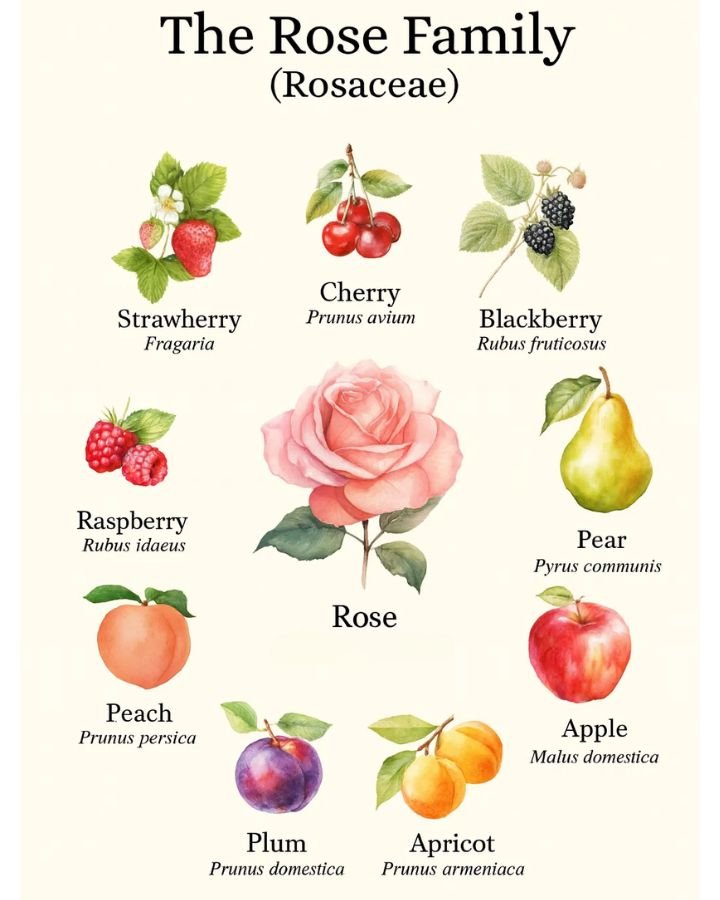
The rose family (Rosaceae) is one of the most useful plant families around. It includes over 3,000 different species, from flowering plants to fruit trees and shrubs. This family gives us way more than just roses. It’s also where we get apples, strawberries, and many other fruits that have been part of our food supply for thousands of years.
The Rose (Rosa)


Roses come from the Rosa genus, which has about 300 species. Most are native to Asia, Europe, and parts of North America. Wild roses grew here naturally before Europeans arrived. Settlers brought cultivated varieties from Europe in the 1600s. People have been growing roses for around 5,000 years, starting in China. They do well in mild climates and represent love and beauty in many cultures.
Strawberry (Fragaria)
The strawberries we grow today came from mixing two American species together in France during the 1700s. Wild strawberries grew in North America long before that, and Indigenous people ate them regularly. The Chilean strawberry also played a part in creating modern types. People started growing them commercially in the U.S. in the early 1800s. These low plants spread by sending out runners and produce fruit in late spring and early summer.
Cherry (Prunus avium)
Sweet cherries originally came from the area between the Black and Caspian Seas. They spread through Europe over time. Settlers brought cherry trees here in the 1600s. By the 1800s, commercial growing took off, especially in Michigan, Washington, and Oregon. The trees lose their leaves in winter and put on white flowers each spring before making fruit. They need cold winter weather to produce well.
Blackberry (Rubus fruticosus)
This blackberry comes from Europe, but many similar types are native to North America. Wild blackberries grew all over the continent. Indigenous people used them for food and medicine. European types arrived with colonists in the 1600s. Blackberries grow on thorny canes that live for two years. They make white or pink flowers, then berries that go from red to dark purple-black. These plants spread easily through their roots.
Raspberry (Rubus idaeus)
Red raspberries started in Europe and Asia Minor. Related types grew naturally in North America, and Indigenous people picked them for food. European varieties came over with settlers and became commercial crops by the 1800s. Raspberries have roots that live for years and canes that live for two. They like cool weather and soil that drains well. Some types fruit in summer, others in fall.
Pear (Pyrus communis)
European pears came from Western Asia and Europe. People grew them as far back as ancient Greece and Rome. Colonists brought pear trees to North America in the early 1600s. Commercial orchards showed up during the 1800s, mainly in California, Oregon, and Washington. Pear trees live a long time and lose their leaves in winter. They need pollen from a different pear tree to make fruit. They bloom early in spring with white flowers. Pears ripen better after you pick them.
Apple (Malus domestica)
Apples originally came from the mountains of Central Asia, specifically Kazakhstan. Colonists brought apple seeds and trees here starting in the early 1600s. Johnny Appleseed helped spread apple growing across the frontier in the early 1800s. Apple trees lose their leaves in winter and need a cold dormant period. They need pollen from different apple varieties to produce fruit. There are thousands of types worldwide, good for cooking, eating fresh, and everything in between.
Peach (Prunus persica)
Even though the scientific name suggests Persia, peaches actually started in China over 4,000 years ago. Spanish explorers brought them to North America in the 1500s through Florida and Mexico. By the 1600s, they grew throughout the colonies, doing especially well in the Southeast. The trees make pink flowers before the leaves come out. They need cold winters and regular pruning. Some types have pits that come out easily, others don’t.
Plum (Prunus domestica)
European plums came from near the Caspian Sea, probably as a mix of two wild types. Settlers brought plum trees here during colonial times and started growing them by the 1600s. Native American plum species already grew wild across the continent. Plums do well in mild climates on small to medium trees that lose their leaves. They make white flowers in early spring and produce more fruit when they get pollen from another tree.
Apricot (Prunus armeniaca)
Apricots started in China over 4,000 years ago and spread west through Central Asia. Spanish missionaries brought them to California in the 1700s, where the weather suited them perfectly. Commercial growing really got going in the 1800s. These small trees bloom very early, which means late frosts can damage them. Apricots can pollinate themselves and make fragrant pink or white flowers. California still grows most of America’s apricots.
The rose family really does offer a little bit of everything—beautiful flowers and plenty of good fruit. These plants traveled across the world over many centuries to end up in our gardens and on our tables.

